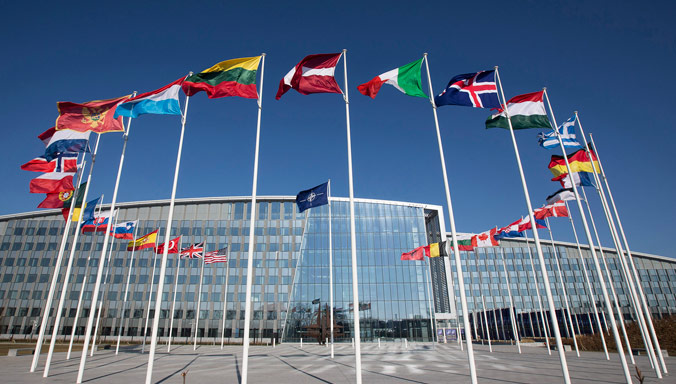
The North Atlantic Treaty Organization (NATO) is an alliance
of nations built on the idea the Soviet Union needed to be contained
militarily. There was genuine concern among Western European countries
(Germany, France, England) that the Soviets posed a threat to a weekend Europe
after World War II. NATO tied together these concerns, along with the United
States and Canada, in a defensive pact to deter Russian aggression.
Since the fall of the Soviet Union in 1991 a lot of people
question the overall goal of the pact. Is it still essential now that the
Soviet Union is gone? What is the strategic objective for the alliance? NATO is
just as important today because Russian is just as determined to gobble up weak
nation states. It has some problems though and lack of European commitment to spending is chief among them. President Trump was right to point it out, but he is wrong
to disparage the idea of a unified front.
NATO countries agreed to 2% of GDP spending
requirement from each of its 29 member countries. So far only Greece and
Estonia have ponied up. President Trump was in Brussels last week for a summit
on the future of the organization. Most of what is getting attention is his
dressing down of Angela Merkel for her country’s lack of spending and indebtedness to Russian energy companies. Trump
criticizes NATO members as often as he can, either in Tweet form or in
speeches. His complaint reflects commonly held views that alliance members are
shirking their payments at the expense of domestic goals. NATO acts as a type
of military welfare for European members that don’t want to pay for a standing
army. It’s easy to avoid payments when the bulk of the money is being spent by
the U.S. But by focusing on the spending only, we miss the secondary benefits
of having so many sovereign nations on our side.
After 911 the coalition supported the invasion of
Afghanistan and later the invasion of Iraq. It might seem like a small offering
but considering NATO members support others who’ve been attacked, it was a big
ask. Iraq in particular cost Tony Blair a lot of support at home. It wasn’t a
traditional war either in which country A needs help from an invading country
B. It was more preemptive, remove Saddam before he attacks. Also, when the US
needs votes at the United Nations it’s often the NATO countries that vote with
us. If the United States insists on taking votes at the U.N. and NATO for military incursions (Iraq, Libya) it will need partners along the way.
How many military bases could we keep in Italy without an
agreement? Germany? Spain? Chances are, not too many. There may be a time when
we aren’t able to house bases inside other countries. When that happens
cooperation between nations is even more important for any conflict or
peacekeeping mission, not to mention more expensive. Even the reluctant Turks
have a U.S. Air Force base.
Despite the problems among members, the threat posed by
Russian incursion into Eastern Europe is more real now than it was in the
1990’s. President Putin annexed (a nice way of saying “stole”) Crimea from
Ukraine and went to war in Georgia a few years before that. It’s dangerous to
oppose Putin if you live in the former Soviet bloc. Since the Soviet Union fell
apart under Gorbachev in the late 80’s, a lot of diplomats assumed Russian was
finished. Communism proved unable to hold together the disparate countries that
fell under their control. It wasn’t in a position to expand; it lost former
territories like the Baltic states and Georgia and Armenia. But Putin regained
a lot of power that was lost in the chaotic 90’s. Mostly through energy
contacts, he is exerting control over much of the former soviet bloc countries.
The roots of cooperation between Western Europe and the
United States started after the war. A battle weary continent might have fallen
under Stalin if not for that cooperation. After World War II the allies
essentially made a bet, rebuild Western Europe and hold off Soviet expansion. By
shoring up businesses in West Germany and reinforcing democratic norms, the
influence of Communism would be restricted to Eastern Europe and the West under
Capitalism. In this way, they kept a potential problem (Soviet aggression)
contained and prevented another massive European war. This is like two fighting
brothers drawing a line down the center of their shared bedroom and labeling
their stuff. Over there is your side, here is my side. It helps to prevent
major conflicts but practically guarantees the minor ones that
characterized the Cold War.
Communism feeds on
desperate people who have neither rule of law nor freedom of movement. It’s an
absolutist form of government that rewards brutality, crushes opposition and
restricts religion. And it’s much easier to install in poor countries than
wealthy ones. In other words the allied gamble was for prosperity. It worked.
People know it the Marshall Plan because that was the where the big spending on
infrastructure and aid happened. But NATO was an outgrowth of the same spirit
of cooperation among democratic allies after the war. The U.S. was in the best
position to offer aid as a bulwark against the chaos of Communism.
The best option today is to scale back the mission
of NATO resembling something closer to the founding principle, by laying down
markers to prevent too much Russian meddling. The Trump administration approved
the sale of some weapons to the Ukrainian government at the end of last year.
Sending weapons (although a small amount) is a signal to Putin that NATO
opposes his incursion into that country. It's a good start at least.
President Trump should make sure U.S. ambassadors hold the
line on spending. It is part of the original agreement after all. I’m sure the
European leaders hate Trump’s brutally honest assessment. He needs to direct
some of that bluntness toward the Kremlin. This Atlantic treaty should survive
despite the problems we have with the lack of commitment from some of the
members. The alternative is a strong Russia and a diminished role for the U.S.
It may come to that, but it doesn’t have to.




